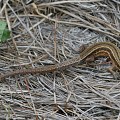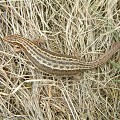
The VIVIPAROUS LIZARD is sometimes confused with the female sand lizard, but that species is more robust, with a larger, deeper head. Total (body+tail) length up to 18 cm. Back reddish-brown or greyish-brown. Females have a dark, almost black, stripe along the spine from neck to beginning of tail; this is often broken up in males. A brownish band along the upper flanks, composed of dark blotches and light spots, gives a marbled impression. Belly rather dark, from ochre to brick-red with black speckles. In some individuals both back and belly may be black. Males and females similar, but orange belly usually signifies males, which may also have ring markings (ocelli). Young are similar to adults, but sometimes darker.
Distibution map by our National Herpetological Mapping Program:




















